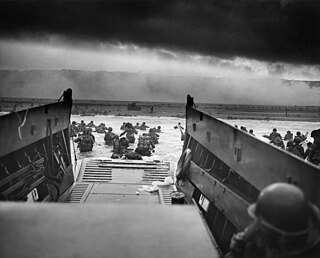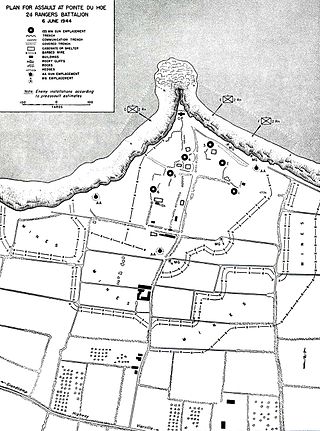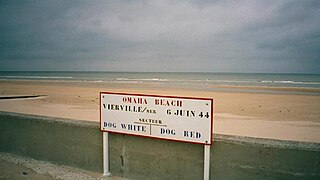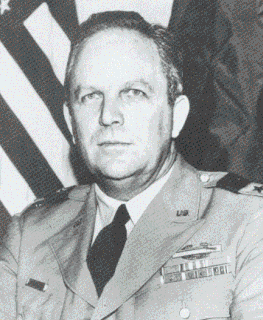
Omaha Beach was one of five beach landing sectors of the amphibious assault component of Operation Overlord during the Second World War.

The Normandy landings were the landing operations and associated airborne operations on 6 June 1944 of the Allied invasion of Normandy in Operation Overlord during the Second World War. Codenamed Operation Neptune and often referred to as D-Day, it is the largest seaborne invasion in history. The operation began the liberation of France, and the rest of Western Europe, and laid the foundations of the Allied victory on the Western Front.

Margaret Ellen "Peggy" Noonan is a weekly columnist for The Wall Street Journal and contributor to NBC News and ABC News. She was a primary speechwriter and Special Assistant to President Ronald Reagan from 1984 to 1986 and has been right-leaning in her writings since leaving the Reagan administration. Five of Noonan's books have been New York Times bestsellers. Noonan was nominated for an Emmy Award for her work on America: A Tribute to Heroes.

Cricqueville-en-Bessin is a commune in the Calvados department in the Normandy region in northwestern France.

La Pointe du Hoc is a promontory with a 35-metre (110 ft) cliff overlooking the English Channel on the northwestern coast of Normandy in the Calvados department, France.

The 5th Ranger Infantry Battalion was a Ranger battalion activated during World War II on 1 September 1943 at Camp Forrest, Tennessee. By this time, while in maneuvers on the United States, they were commanded by the Major Owen Carter. Later, when they moved to England, they were commanded by Major Max Schneider, former executive officer of the 4th Ranger Battalion, who led the 5th Rangers as part of the Provisional Ranger Group commanded by Colonel James Earl Rudder.

Saint-Pierre-du-Mont is a commune in the Calvados department in the Normandy region in northwestern France.

Vierville-sur-Mer is a commune in the Calvados department in Normandy region in northwestern France.

A grappling hook or grapnel is a device that typically has multiple hooks attached to a rope or cable; it is thrown, dropped, sunk, projected, or fastened directly by hand to where at least one hook may catch and hold on to objects. Generally, grappling hooks are used to temporarily secure one end of a rope. They may also be used to dredge for submerged objects.

James Earl Rudder was a United States Army major general. As a lieutenant colonel, he commanded the historic Pointe du Hoc battle during the Invasion of Normandy. He also commanded the US troops at the Battle of the Hürtgen Forest, and led a series of delaying actions and ambushes during the Battle of the Bulge. General Rudder also at various times served as Texas Land Commissioner, the 16th president of Texas A&M University, third president of the Texas A&M University System, mayor of Brady, Texas, and a high school and college teacher and coach.

The Brécourt Manor Assault during the U.S. parachute assault of the Normandy Invasion of World War II is often cited as a classic example of small-unit tactics and leadership in overcoming a larger enemy force.

USS Satterlee (DD-626) was a Gleaves-class destroyer in the United States Navy during World War II. She is the second Navy ship named for United States Coast Guard Captain Charles Satterlee.

The 2nd Ranger Battalion, currently based at Joint Base Lewis–McChord south of Seattle, Washington, United States, is the second of three ranger battalions belonging to the United States Army's 75th Ranger Regiment.

D-Day the Sixth of June is a 1956 American DeLuxe Color CinemaScope romance war film made by 20th Century Fox. It was directed by Henry Koster and produced by Charles Brackett from a screenplay by Ivan Moffat and Harry Brown, based on the 1955 novel, The Sixth of June by Lionel Shapiro. The film stars Robert Taylor, Richard Todd, Dana Wynter, and Edmond O'Brien.

Leonard G. "Bud" Lomell was a highly decorated former United States Army Ranger who served in World War II. He is best known for his actions in the first hours of D-Day at Pointe du Hoc on the coast of Normandy, France.
Gerald William Heaney served for nearly forty years as a United States Circuit judge of the United States Court of Appeals for the Eighth Circuit, from his appointment by President Lyndon B. Johnson in November 1966 until his full retirement in August 2006.

Robert Lee "Bull" Wolverton was the commander of the American 3rd Battalion, 506th Parachute Infantry Regiment, 101st Airborne Division, from 1942 until his death at Saint-Côme-du-Mont, Normandy, on D-Day, June 6, 1944, during World War II.
The Provisional Ranger Group was a provisional regiment of U.S. Army Rangers that was formed for the D-Day landings in Normandy, France, in World War II.
Bently Thomas "Ben" Elliott is an American writer who served as President Ronald Reagan’s director of speechwriting from 1982 to 1986. In this capacity he directed better known speechwriters like Peggy Noonan and Peter Robinson, both of whom he hired.

The Maisy Battery is a group of World War II artillery batteries that was constructed in secret by the German Wehrmacht near the French village of Grandcamp-Maisy in Normandy.

















